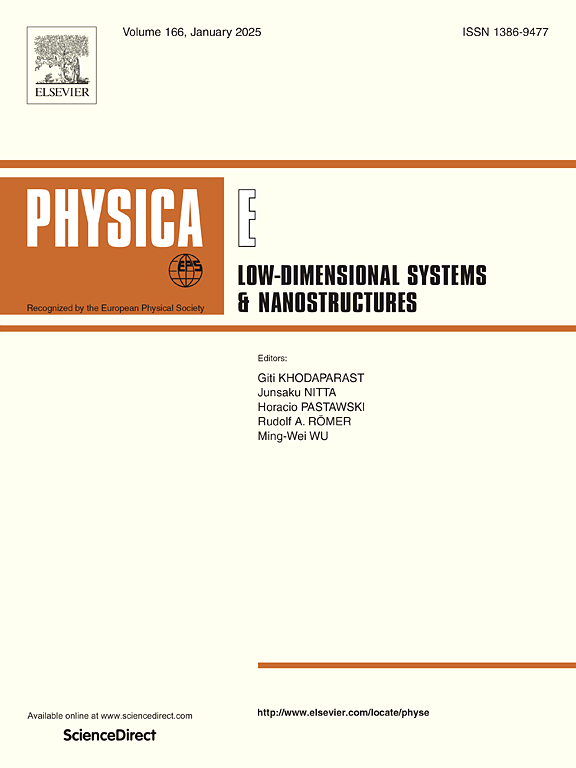太赫兹范围内的单层黑磷增强型窄带完美吸收器
IF 2.9
3区 物理与天体物理
Q3 NANOSCIENCE & NANOTECHNOLOGY
Physica E-low-dimensional Systems & Nanostructures
Pub Date : 2024-10-29
DOI:10.1016/j.physe.2024.116144
引用次数: 0
摘要
本文提出了一种基于黑磷 (BP) 的窄带吸收器。通过利用单层 BP、带有四个蚀刻孔的硅结构和完全导电 (PEC) 板,可实现 3.8 THz 至 5.0 THz 范围内的多波段吸收。三个峰值的位置和吸收率分别为 4.32 THz (99.7%)、4.53 THz (95.6%) 和 4.69 THz (56.7%)。当 TE 和 TM 偏振光源照射时,BP 结构的各向异性会导致不同的吸收光谱。改变 BP 中的电子掺杂量可以控制吸收峰的位置和强度。通过研究吸收体的电场分布,可以明显看出主导物理机制是局部表面等离子体共振(LSPR)。总之,本研究设计的单层 BP 吸收体可用于构建红外波长的极性传感器。此外,它还为二维各向异性等离子体设备提供了有价值的参考。本文章由计算机程序翻译,如有差异,请以英文原文为准。
Single-layer black phosphorus-enhanced narrowband perfect absorber in the terahertz range
In this paper, a narrowband absorber based on black phosphorus (BP) is proposed. By utilizing a single-layer BP, a Si structure with four etched holes, and a perfectly electrically conductive (PEC) plate, multi-band absorption can be achieved in the range of 3.8 THz to 5.0 THz. The location and absorbance of the three peaks are 4.32 THz (99.7 %), 4.53 THz (95.6 %), and 4.69 THz (56.7 %), respectively. The anisotropy of the BP structure leads to different absorption spectra when illuminated by TE and TM polarized light sources. Altering the electron doping in BP allows control over the position and intensity of absorption peaks. Upon examining the electric field distribution of the absorber, it is evident that the dominant physical mechanism is the localized surface plasmon resonance (LSPR). Overall, the monolayer BP absorber designed in this study can be utilized to construct a polarimetric sensor for infrared wavelengths. Additionally, it provides a valuable reference for 2D anisotropic plasma devices.
求助全文
通过发布文献求助,成功后即可免费获取论文全文。
去求助
来源期刊
CiteScore
7.30
自引率
6.10%
发文量
356
审稿时长
65 days
期刊介绍:
Physica E: Low-dimensional systems and nanostructures contains papers and invited review articles on the fundamental and applied aspects of physics in low-dimensional electron systems, in semiconductor heterostructures, oxide interfaces, quantum wells and superlattices, quantum wires and dots, novel quantum states of matter such as topological insulators, and Weyl semimetals.
Both theoretical and experimental contributions are invited. Topics suitable for publication in this journal include spin related phenomena, optical and transport properties, many-body effects, integer and fractional quantum Hall effects, quantum spin Hall effect, single electron effects and devices, Majorana fermions, and other novel phenomena.
Keywords:
• topological insulators/superconductors, majorana fermions, Wyel semimetals;
• quantum and neuromorphic computing/quantum information physics and devices based on low dimensional systems;
• layered superconductivity, low dimensional systems with superconducting proximity effect;
• 2D materials such as transition metal dichalcogenides;
• oxide heterostructures including ZnO, SrTiO3 etc;
• carbon nanostructures (graphene, carbon nanotubes, diamond NV center, etc.)
• quantum wells and superlattices;
• quantum Hall effect, quantum spin Hall effect, quantum anomalous Hall effect;
• optical- and phonons-related phenomena;
• magnetic-semiconductor structures;
• charge/spin-, magnon-, skyrmion-, Cooper pair- and majorana fermion- transport and tunneling;
• ultra-fast nonlinear optical phenomena;
• novel devices and applications (such as high performance sensor, solar cell, etc);
• novel growth and fabrication techniques for nanostructures

 求助内容:
求助内容: 应助结果提醒方式:
应助结果提醒方式:


